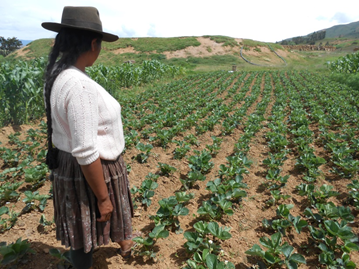Community irrigation increases agricultural production in Bolivia
Bolivia has a population of 10 million and covers more than 1 million km² (1), i.e. 30 times the size of Belgium. Only 3% of the land is cultivated and 11% of this acreage, or 300,000 hectares, is irrigated (2). While irrigation in Bolivia dates back to pre-Columbian times and lingers in several indigenous communities, the lack of irrigation is a major constraint to agricultural development in Bolivia, which has the lowest irrigated surface on the continent.
However, irrigation plays a key role in the economics of agriculture. It provides the right conditions to diversify and ensure stable production. It also promotes the modernisation of farming and that way contributes to food security and food sovereignty. A hectare of irrigated land guarantees productivity and provides a higher income than a hectare of non-irrigated land and helps improve the income of Bolivian indigenous rural households.
Support to community irrigation
For this purpose Bolivia and Belgium decided to launch the Support Programme to Community Irrigation (PARC) in 2011. PARC implements projects of community irrigation in 12 Bolivian municipalities in the Cochabamba and Chuquisaca Departments (in semi-arid and arid areas on the Altiplano and in the high valleys). These municipalities suffer from extreme poverty and a lack of irrigation, which limits agriculture to subsistence farming – farmers produce their own food only and cannot invest in inputs or means of production.
Community irrigation projects, based on the tradition of community irrigation, are small irrigation systems with open channels, pipes or reservoirs made of earth that capture rainwater and run-off water and are called "atajados". These family- or community-level systems seek to benefit the greatest possible number of households.Today, PARC has 43 community irrigation projects in various stages of implementation (being studied, implemented or completed). These projects will benefit 1,888 households and add 1,374 hectares of irrigated land in the 12 municipalities involved. Thanks to irrigation the production of potatoes, corn, wheat, tomatoes, onions, peaches and other crops can increase.
Another important result is the draft of the Strategy Plan of the National School of Irrigation and the training of more than 480 farmers and 200 technicians on different irrigation-related topics.
Comprehensive vision of PARC
PARC contributes to the development of irrigation in Bolivia. It differs from other development programmes because of its comprehensive approach. This vision includes farmer participation in every phase of the projects (from design to execution and management), sustainable water supply with attention for soil and water conservation methods, management of the irrigation system by the farmers themselves and agricultural diversification and production as well as the marketing of products if applicable.
PARC activities
PARC is constituted as a process facilitator and has signed 12 execution agreements with Autonomous Local Authorities and two decentralized entities of the Ministry of the Environment and Water, namely the National Irrigation Service (SENARI) and the Environmental and Water Executing Entity (EMAGUA). Through these actors studies are carried out for the preparation and implementation of projects, Comprehensive Community Irrigation Projects are executed and a regulatory framework is defined. Also training is provided through the National School of Irrigation.
The implementation of a comprehensive community irrigation project includes the construction of the infrastructure and protection of the water source, monitoring and comprehensive technical assistance. The comprehensive technical assistance service supports farmers in efficient management of water, maintenance and operation of the system, as well as the production and marketing of products.
Support programme to community irrigation - PARC | Bolivia
- Duration: 2011–2016
- Funding: Belgium, Bolivia
- Overall budget: 11,588,178 euros, of which 9,100,000 euros are financed by Belgium
- Area: Cochabamba and Chuquisaca Departments
(2) Informe de Gestión 2013, Ministerio de Medio Ambiente y Agua Bolivia, p. 63
Dernières actualité de ce projet
Pas d'actualité

